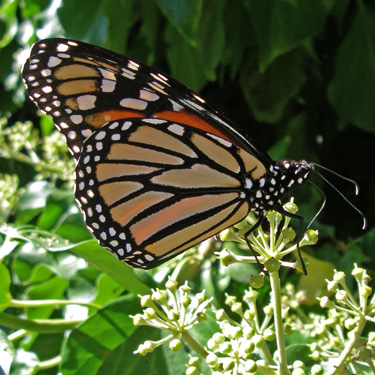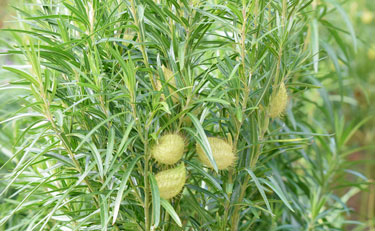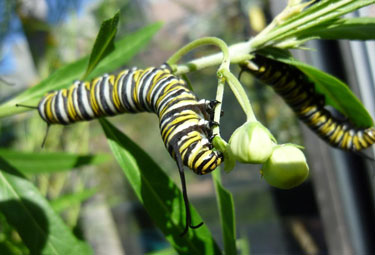Raise Monarchs as easy as ABC
| A | Aphids can be a major deterrent to your swan plant. Healthier plants in healthy soil will usually withstand aphids until such time as their predators or parasites come along and control them naturally – and if you don’t use a pesticide to control them you’re less likely to upset the ecosystem in your garden. |
| B | Buddleia or ‘Butterfly Bush’: arguably one of the most favoured nectar plant by butterflies. |
| C | Cleanliness in caterpillar castles/rearing containers is essential for healthy butterflies. Remove frass. |
| D | Disinfectant. Use disinfectant to avoid problems. Use diluted bleach to wash down equipment, or wash leaves if you think eggs might be diseased. |
| E | Egg-laying by monarchs is prolific. You will need to restrict monarchs’ access to plants if you don’t want to run out of food for your caterpillars. You have to think like a farmer. Don’t overstock! It is better to raise a few caterpillars well. |
| F | Frass – caterpillar poo. |
| G | Glossary – there is an excellent glossary on our website which will help your understanding of new words. We try to keep things simple (egglaying instead of ovipositing) but it also is important to know the correct terminology. |
| H | Host plants. Try to have way more than you need, and make some inaccessible to Monarch butterflies. If you plan in advance you will avert any famine for caterpillars. |
| I | Insecticide – Avoid the use of any pesticides. Monarch butterflies are insects, and we tend to forget about things like flea controls on pets or insect controls that plug in around the house. |
| J | The shape of a caterpillar as they begin the process to pupation. It is a very delicate stage of the Monarch’s life; do not disturb. |
| K | Killing humanely in cases of crippled and diseased butterflies can be done by putting it in the freezer for a day or two. Allowing diseased butterflies to breed is only weakening the species. |
| L | Looking ahead, have as many plants in reserve and protected from egg-laying as you have plants available to the butterflies, these will act as back-ups when all your available plants have been stripped, and will save the panic of starving caterpillars. |
| M | Milkweed: the family of plants on which Monarchs lay. They exude a milky sap which, when ingested by caterpillars, makes them toxic and therefore unattractive to nearly all birds. It is poisonous so be careful to wash your hands well and do not get any in your eyes. |
| N | Cover your host plant with a net such as a mosquito net to limit the amount of eggs that are laid. If the female butterfly can’t lay on your plants, she’ll go to another elsewhere in the community. Alternatively, a net is useful protection for caterpillars – to ensure wasps can’t get at them. |
| O | Ophryocystis elektroscirrha, a protozoan (simple form of animal) infects Monarchs and is most likely to occur when they are under stress, overcrowded or on inferior food. If your Monarchs are dying as caterpillars, not forming chrysalises perfectly, or crippled butterflies are emerging, this could be the problem. Look in the forum for more information. |
| P | Predators and parasites including social wasps, praying mantis, hedgehogs. Controlling known wasp nests can help, as will netting on plants, removing praying mantises. Keep chrysalises out of reach of hedgehogs. You can put chrysalises up high or take them inside for pupation. |
| Q | Questions about Monarchs? Go to the MBNZT forum, www.monarch.org.nz/forum you’ll find lots of information there. |
| R | Regular tip pruning and feeding of plants, and planting more annual colour throughout the season ensures ample flowers for nectar. By pruning off spent heads Buddleias are ideal as a patio plant for people with limited garden space. |
| S | Swan plants with yellow leaves suggests the plant is too dry, is short of some particular mineral/(s) or it could have been nipped by a late frost? If the yellow leaves are near the base of the plant, don’t worry... they’re just showing signs of age and what was once the stem of the juvenile plant is now becoming a ‘trunk’. |
| T | Thorax, this is the midsection of an insect’s body. It holds the legs, wings and abdomen of a butterfly and is in between the head and the abdomen. |
| U | Unclean or unwashed hatching castles can lead to caterpillars and or chysalises becoming diseased and dying. |
| V | Ventilation, very important if caterpillars are being raised indoors as it will keep the air circulating and help to reduce incidence of fungal and bacterial infections. |
| W | Wasps There are several kinds of wasps that are predators or parasitoids. See the MBNZT factsheet on wasps here http://www.monarch.org.nz/monarch/wp-content/uploads/2008/12/wasps-fact-sheet.pdf |
| X | Xerochasy - the opening of seed pods (such as swan plants) and the dispersal of the seeds, especially when they are dry. |
| Y | Yarrow and other weeds much loved by butterflies and moths – dandelion, vetch, clover, nettles, various daisies, chicory, trefoil, speedwell, thistle, plantain, pennyroyal, ragwort, wild radish and wild turnip, wild sweet pea are all nectar-rich. You may not win your street’s ‘Best Kept Garden’ award but the butterflies, moths and other beneficial insects will love you for it! |
| Z | Zinnias and other nectar plants which will feed visiting Monarchs while they mate, lay eggs, and provide the best food for butterflies, and also encourage overwintering in your area if nectar sources are plentiful. |
For more information please visit www.nzbutterflies.org.nz. Article reproduced with permission from the Moths and Butterflies of New Zealand Trust.
Story by Jacqui Knight and forum members
23-Sep-2013

Monarch butterfly on ivy flowers

Monarch butterly feeding on hebe flowers

Swan plant with seed pods

Monarch caterpillars

